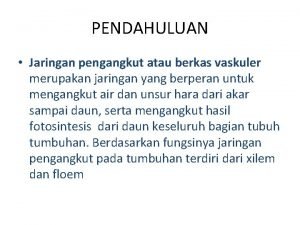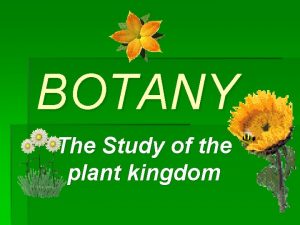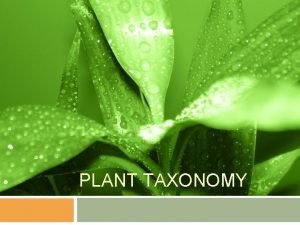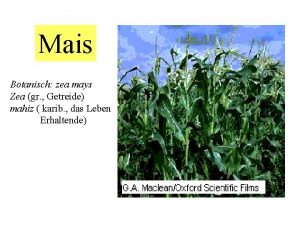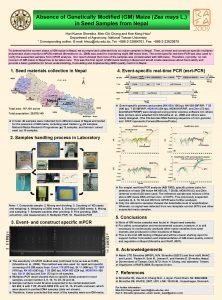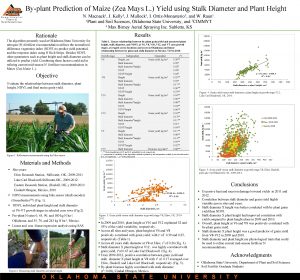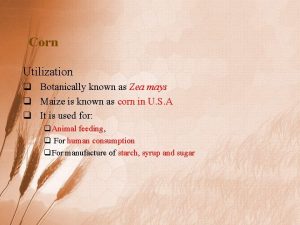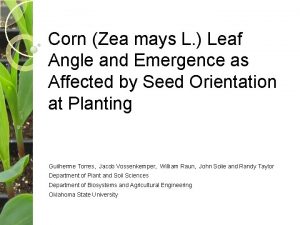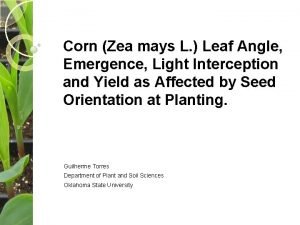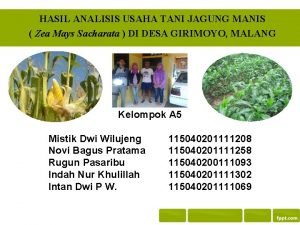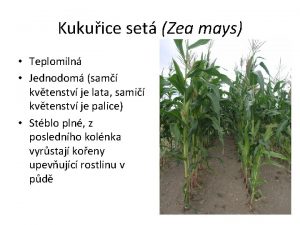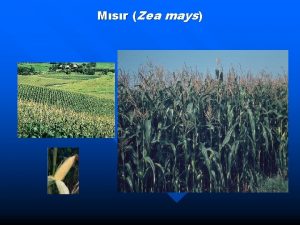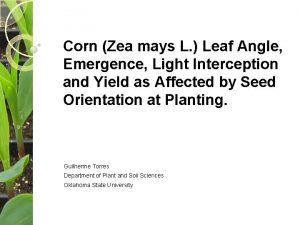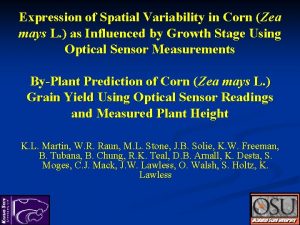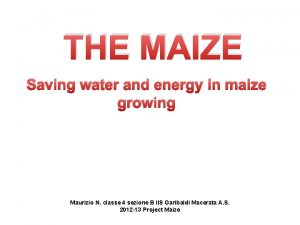PRODUCTION TECHNOLOGY OF MAIZE Maize Zea mays Scientific




















- Slides: 20


PRODUCTION TECHNOLOGY OF MAIZE

Maize ( Zea mays) Scientific classification • Kingdom: Plantae • Order: Poales • Family: Poaceae • Subfamily: Panicoideae • Genus: Zea • Species: Z. mays

ORIGIN & History • Corn plant is indigenous to America and principle food grain of native Americans • It was domesticated 8000 years ago • For western civilization, the story of corn began in 1492 when Columbus's men discovered this new grain in Cuba. • Archeological evidence of corn's early presence in the western hemisphere was identified from corn pollen grain considered to be 80, 000 years old obtained from drill cores 200 feet below Mexico City Lance Gibson and Garren Benson, Iowa State University, Department of Agronomy Revised January 2002.

INTRODUCTION • • • Highest yielding cereal crop in the world 3 rd most grown crop in world 3 rd largest grown cereal crop in Pakistan 4 th largest crop grown crop in Pakistan Rich source of starch, vitamins, proteins and minerals

INTRODUCTION World production World area Total Pakistan area Total production 600 million metric tons 118 million hectare 1 million hectare 3. 5 million metric tons Contribution of different provinces to total area 1. 2. 3. 4. Punjab KPK Sindh Balochistan 39% 56% 5% 3%

Uses of maize Its flour is used For • Making breads • Noodles • Confectionery • Custards (thinking agent) • Jellies (thinking agent) An unleavened bread called makki di roti is a popular bread eaten in the Punjab region of India and Pakistan. • Edible oil • Levulinic acid (used as ingredient in anti freeze) • plastic and fabrics are made from corn stocks • Ethanol used as biomass fuel • Corn silk used as herbal supplements

Production Technology

Soil and climate • Maize is adapted to wild variety of soil and climate • Well drain heavy soils with high organic matter content and good water holding capacity. • p. H 6. 5— 7. 5 • Tem. For flowering more than 10 c°

Seed bed preparation • Fine and compact bed needed • Land is loosened 20 to 25 cm deep through ploughing or disking 2– 3 times • Planking

Sowing time Maize is planted in two seasons 1. Autumn First weak of February up to first week of March 2. Spring Last week of July to mid of august

Seed rate and verities 12— 15 kg per acre (for drill sowing) 8— 10 kg per acre (for bed sowing) • Hybrid verities • Corn— 8288 • NK— 8001 • X— 2276 • Monsanto– 6525

Sowing method • Maize can be sown on flat soil as well as ridges Ø For ridge sowing ü 75 cm apart ridges are made with ridger üChoka method or manual sowing is practiced Ø For flat sowing üAutomatic tractor drawn drill or hand drill with 75 cm distance between rows is used üThining is done after 10— 15 days of emergence

Sowing method ØPlant to plant distance 20— 25 cm ØPlant population should be 70— 75 thousand per hectare Fertilizer Ø NPK @ 150— 100 kg per hectare respectively Ø All phosphorus & potassium and half Nitrogen side dressed Ø N is added in two splits first at knee height second at tasseling

Irrigation Requires frequent irrigation Irrigation 10— 15 days intervals Drought will reduce yield Moisture stress at critical stages can reduce yield up to 40% • Total irrigations • • Ø 6— 9

Plant protection measures v. Maize crop faces serious threat after emergence ØShoot fly ØStem borer v. Solution ØFuradan powder should be dropped into shoots @ 20 kg/hectare

Plant protection measures v. Weeds üReduced yield 29— 43% v. Common weeds üDeela üItsit ü Jangli chulai ü Tandla ü Jangli swank ü Jangli haloon

Harvest & storage • Harvested when moisture content of grains are 20— 25 % • Hand operated or powered maize shellers can be used • Store at moisture content 15% • Temperature for storage 20— 25 c° • Humidity 30— 50 %

Yield • Hybrid has potential 125— 130 mounds per acre

 Perbedaan kolateral konsentris dan radial
Perbedaan kolateral konsentris dan radial Zea mays leaf cross section labeled
Zea mays leaf cross section labeled Zea mays leaf cross section labeled
Zea mays leaf cross section labeled Monocot คือ
Monocot คือ Family genus species order
Family genus species order Maize production technology
Maize production technology Pre post production
Pre post production Zea eagle
Zea eagle Paola zea
Paola zea Jonathan zea
Jonathan zea Mays transformational leader mindsets
Mays transformational leader mindsets Mays ibraheem
Mays ibraheem Mays ibrahim
Mays ibrahim Mays ibrahim
Mays ibrahim Deming'in pukö çevrimi elemanları
Deming'in pukö çevrimi elemanları Slow machines lesson 2
Slow machines lesson 2 Mays ibrahim
Mays ibrahim Scientific inquiry vs scientific method
Scientific inquiry vs scientific method How is a scientific law different from a scientific theory?
How is a scientific law different from a scientific theory? Maize germ uses
Maize germ uses Maize gdb
Maize gdb
